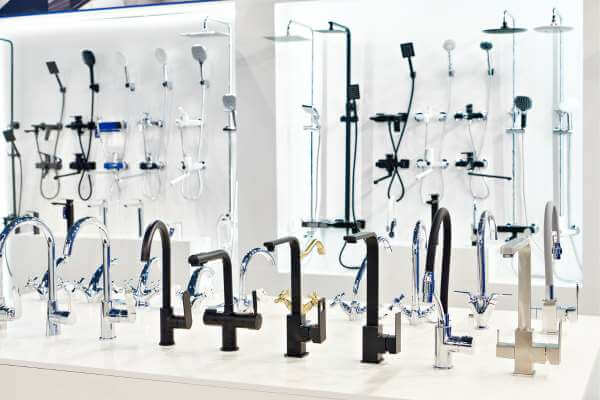Garbage disposals, like most household appliances, can experience occasional issues. They may emit a humming sound rather than grinding up food waste or fail to drain properly. This can be a particular headache since kitchen sinks typically rely on garbage disposals to function smoothly.
If your kitchen sink is filling up with water and your garbage disposal doesn’t seem to be affected by the problem, you’ll have to take action. In this article, we’ll go over some possible solutions on How to Unclog a Garbage Disposal with Standing Water.
What Could be Causing my Garbage Disposal to Push Water Back Up?
In most cases, if your garbage disposal is causing water to flow back into your sink, the problem can be traced to a single source: a blockage. The obstruction might take different forms, such as a foreign item obstructing the drain opening or a lump of food particles stuck in the drain pipe.
Nonetheless, there are situations when a small amount of water push-back is to be expected. After cleaning your garbage disposal with ice, you may observe a buildup of gunk rising out of the drain. As the system processes the ice, the grime and debris will swirl back down into the drain, resulting in a more hygienic disposal unit.
How to Unclog a Garbage Disposal with Standing Water?
Using commercial chemicals to unclog your garbage disposal is not recommended, despite their widespread availability online and in stores.
Chemical clog removers work well but are not advised as they can harm pipes.
Instead, it’s generally best to identify the underlying cause of the clog, whether it’s due to trapped food or an object lodged in the system.
Unclogging a garbage disposal is generally a straightforward process, although some issues may be more complicated than others. Before calling in a professional plumber, it’s worth attempting the following methods.
Search for Any Foreign Objects
It’s advisable to inspect the garbage disposal canister for any foreign objects that may have become lodged inside. Occasionally, unidentifiable objects may end up in the canister, and while it’s unclear how they got there, their presence cannot be ignored.
To begin, turn off the power supply to the unit by shutting off the switch on the wall or circuit box (if necessary) and unplugging the unit. Once the power is off, use a cup and a bucket to remove any excess water from the sink.
Using the flashlight, peer into the canister to inspect its interior. You may need to move the baffle (the black rubber component surrounding your kitchen sink drain) aside for a better view.
If you spot an object at the bottom of the canister, use a pair of pliers or tongs to retrieve it. It’s important to never attempt to reach inside the canister with your hands, even if the power is off. After removing the object, restore power to the unit and check for proper drainage and operation.
Use A Sink Plunger
If there are no visible objects at the garbage disposal’s canister, the obstruction probably located deeper in the drain tube. To remove the blockage, you can use a sink plunger. Unlike toilet plungers, these plungers are specifically designed for use in sinks.
Place the plunger over the drain opening and ensure that it covers the entire mouth to create suction. Fill the sink with enough water to cover the plunger cup, then vigorously plunge the drain 4-5 times. After that, remove the plunger from the drain.
If the water drains quickly, then the blockage is cleared. However, if the water still doesn’t drain, you may need to try again. If the blockage persists after a few attempts, move on to the next method.
Spin The Blades Manually
Occasionally, a small amount of debris can become entangled around the blades of the garbage disposal. This can prevent the unit from effectively breaking down food waste, leading to a buildup of larger food particles that can clog the disposal and cause water to back up into the sink.
If you suspect that the disposal blades are obstructed by debris, you can use a hex wrench and the small hole located at the base of the canister to manually turn the blades. This hole is usually located at the very bottom of the disposal unit. It is used to manually rotate the blades in case they get stuck. By inserting the hex wrench into the hole and turning it back and forth, you can dislodge any debris or objects that are stuck in the blades. Remember to turn off the power to the disposal unit before attempting this method.
Remove The P-Trap
In some cases, plunging the sink and rotating the blades won’t solve the issue. The reason is the blockage located deeper in the drain tubes, near the P-trap. The P-trap is the pipe shaped like a U that is situated beneath your sink and contains air, which prevents foul-smelling sewer gases from coming out of your sink drain.
Before starting, position a large bucket beneath the P-trap as water may spill out when the trap is removed. You should also ensure that the bucket is big enough to catch the water in the sink. If the clog is located in this part of the plumbing, the water in the sink will drain out when you take off the trap.
If the P-trap is held in place by screws, unscrew them. However, if it is attached with a large plastic nut, unscrew the nut instead.
First, loosen the trap and carefully remove it from the plumbing assembly. Then, let the water flow into the container below. Next, inspect the P-trap for any obstructions and eliminate them if required. In case you don’t find any blockages in the P-trap, examine the rest of the plumbing.
Insert a plumbing auger into both ends of the pipe to detect any obstructions that may be causing the problem. If you encounter any resistance, turn the handle of the auger to loosen the blockage and pull it out of the pipe.
After removing the blockage, reattach the P-trap and secure it to the plumbing system. Once the trap is secured, turn on the water and verify that the garbage disposal is functioning correctly and draining properly. Keep an eye out for leaks around the P-trap and fix them if you notice any leakages.
Use Vinegar and Baking Soda

If there is an excessive amount of water backed up in the sink, this solution may not be effective for dislodging clogs in garbage disposals. However, it can be a useful drain cleaner for partially cleared blockages. For instance, if you have attempted one of the above techniques and have achieved some success, but the system still drains sluggishly, this solution can be beneficial.
In such a scenario, complete the cleaning process with a mixture of baking soda and vinegar. The chemical reaction between these two substances can effectively dislodge any remaining stubborn particles of the blockage, ensuring that the garbage disposal and drain remain free from obstructions. Additionally, the mixture acts as a natural cleaning and deodorizing agent that can efficiently eliminate unpleasant odors from the system.
To use the baking soda and vinegar solution, start by pouring around one cup of baking soda into the garbage disposal. Without delay, add one cup of distilled white vinegar. The mixture will cause bubbling and foaming as the two substances interact.
Allow the mixture to sit and work for at least 20 minutes while it continues to bubble and fizz. Once the reaction slows down, turn on the hot water and run it down the sink to flush out any leftover debris. This process will leave you with a clean and fresh-smelling garbage disposal.
Call A Plumber
If your attempts to clear a clogged drain are unsuccessful, it’s best to contact a plumber. There may be a blockage deep within the pipes that is beyond your reach or expertise to locate, and a plumber can assist you in resolving the issue. Additionally, if you’re unable to identify the problem causing the backed-up water in your sink, a plumber can diagnose the issue and restore proper drainage.
FAQ
Why is my garbage disposal pushing water back up?
When you observe water backing up in your kitchen sink, it’s likely that one of three scenarios has occurred: There is a blockage present, your disposal has been overworked, or there was an improper installation of the garbage disposal unit.
How to Unclog a Garbage Disposal with Standing Water?
To start, sprinkle baking soda into the garbage disposal, followed by pouring vinegar into it. Allow the mixture to fizz for about 20 minutes to break down the clog. Finally, flush away the mixture and any remaining food debris with hot water through the pipe.
Can plunging make a clog worse?
Trying to push a toilet blockage down with a plunger may aggravate the situation. Rather, create an airtight seal and gradually press down on the plunger, then pull it back vigorously. This will create suction to draw the clog up and break it, enabling gravity to do the rest.
Can Coke unclog a drain?
Coke and Pepsi contain a significant amount of phosphoric acid. This Acid is capable of breaking down and removing buildup that may cause clogged drains. In addition to unclogging drains, phosphoric acid has the potential to eliminate challenging lime scale and other forms of buildup that ordinary cleaning agents may have difficulty addressing. This natural remedy is not only efficient, but also refreshing!
Conclusion
Dealing with a clogged garbage disposal can be a frustrating experience, especially when there’s standing water in your sink. However, by following the steps outlined in this article on How to Unclog a Garbage Disposal with Standing Water, you can safely and effectively clear the blockage and prevent future clogs. Remember to always prioritize safety, avoid using harsh chemicals, and regularly maintain your disposal to prevent issues in the future. With these tips, you can quickly and easily unclog your garbage disposal and get your kitchen sink running smoothly again.
Read also: How to Fix Leaking Kitchen Faucet
Why is My Touchless Faucet not Working?


 Hi, my name is Debra Klein and I love modern kitchen designs! As a product reviewer, it’s my mission to help homeowners choose the right modern kitchen accessories for their homes. I want to give them the best solution possible so they can make the best decision for their needs. Thanks for reading!
Hi, my name is Debra Klein and I love modern kitchen designs! As a product reviewer, it’s my mission to help homeowners choose the right modern kitchen accessories for their homes. I want to give them the best solution possible so they can make the best decision for their needs. Thanks for reading!




